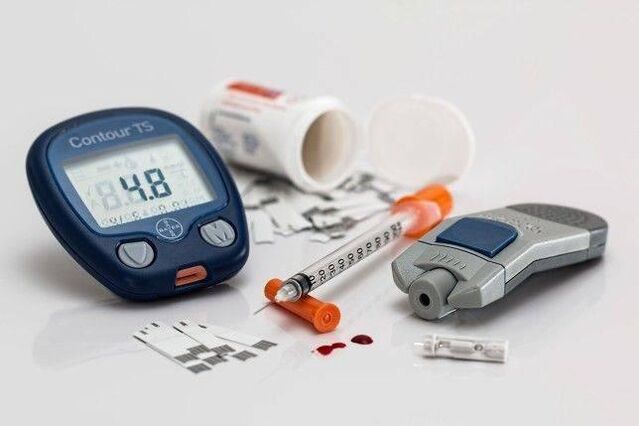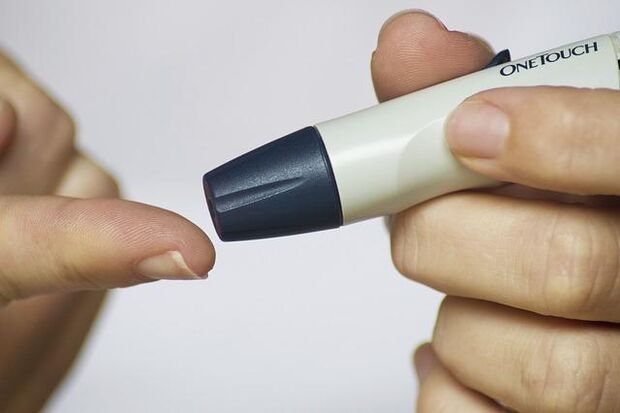
Diabetes mellitus is a severe endocrine disease with severe insulin deficiency. The disease is considered incurable, and home treatment with folk remedies only weakens the symptoms.
There are many reasons for the appearance of the disease. A viral disease, genetic predisposition, medication, or a difficult pregnancy can trigger a seizure.
types of diabetes
The disease has prominent symptoms and signs, like bronchitis or cough. Depending on them, 5 types of diabetes are distinguished.
- 1 type. The immune system attacks the pancreas, which does not release the right amount of insulin, which is responsible for glucose metabolism. Traditionally, type 1 diabetes was a problem for young people. Among diabetes cases, the first type accounts for a tenth.
- type 2. Human organs and tissues lose their sensitivity to insulin. It is noteworthy that the pancreas produces this substance in normal amounts. The second type of disease affects 90% of diabetics.
- gestational diabetes. Appears exclusively in women during pregnancy. This type of diabetes mellitus differs from other forms in that it often disappears after the birth of a child. Only 5 percent of expectant mothers experience it.
- secondary diabetes. A health condition in which various disorders cause glucose levels to rise. This type is considered to be the result of hormonal imbalances, medications, chronic pancreatitis, or removal of the pancreas.
- prediabetes. Appears when there are no health problems. The patient's glucose is at the level of the maximum normal rate for a long period of time. It is caused by heredity, improper lifestyle, malnutrition and obesity.
Diabetes of the first two types cannot be completely cured. However, with the help of diet, treatment, and moderate exercise, people with this diagnosis can live long and normal lives.
Symptoms of Diabetes

The symptoms of the disease often do not appear immediately. As a result, the disease hides for a long time without revealing its presence.
In medicine, there are cases when the appearance of diabetes surprises a person. The patient goes to the doctor for advice on a specific disease, and after passing the tests, he learns about diabetes.
People often suffer from two types of diabetes, each with its own set of symptoms. Several common symptoms can be identified.
- thirst. One of the main messengers of diabetes, regardless of the type. But other diseases also cause thirst, so doctors do not focus on this symptom when making a diagnosis.
- Frequent urination. The symptom is characteristic of both types of the disease. Frequent urination often signals a violation in the urinary system.
- fatigue. Drowsiness and chronic fatigue are symptoms associated with all types of diseases, which include diabetes mellitus.
- Low temperature. Most often, in people suffering from an illness, the body temperature is reduced - below 36 degrees.
- Rapid weight loss with increased appetite. People who constantly want to eat and lose weight for no reason are advised to be vigilant and undergo an examination.
- Low tissue regeneration. With diabetes, even minor skin damage takes a long time to heal. Often there are ulcers and weeping sores.
- visual impairment. Some diabetics complain that a white "veil" appears in front of their eyes and the image becomes blurry. But vision can deteriorate with age.
- Circulatory disorders in the limbs. Manifested by tingling and numbness. Often there are cramps in the calf muscles.
- deterioration in potency. Diabetic men often have erection problems. In women, the disease causes dryness of the genitals.
Remember that the severity of the symptoms depends on the characteristics of the body. In one person, the listed symptoms are pronounced, while in the other they are absent. The stage of the disease also affects the severity of the symptom. With severe violations of insulin secretion, the symptoms are more pronounced.
Treatment of diabetes with folk remedies
Diabetes occurs when the pancreas fails to do its job and releases small amounts of insulin. This substance helps the body break down sugar. As a result, excess sugar is excreted in the urine. And although doctors are constantly analyzing the course of the disease, effective methods of treatment have not yet been developed.
It is allowed to treat diabetes mellitus at home with folk remedies under the obligatory supervision of an endocrinologist. The main factor in therapy affecting the course of the disease is diet.
Carbohydrates are excluded from the diet. If this is not possible, their consumption is reduced. Instead of regular sugar, it is recommended to use xylitol, sorbitol or products containing starch.
The list of folk remedies used in the treatment of diabetes is represented by natural fruits, vegetables, medicinal plants and berries. Individual components are often used together, which increases the healing effect.
- Klee infusion. Combine one part clover grass with the same amount of boiling water and wait three hours. Drink the drug before a meal for 0. 33 cups. Add flowers to enhance the effect.
- blueberry leaves. Pour a cup of boiling water over a spoonful of dried leaves, wrap and wait 30 minutes for the liquid to absorb. After carefully straining the infusion, drink a cup three times a day.
- walnut leaves. Grind two dozen green walnut leaves, put them in a saucepan, pour a glass of liquid, boil and simmer for 10 minutes. Take the remedy during the day without restrictions.
- herb collection. Mix twenty grams of blueberry leaves, birch buds, pansies and nettles, add five grams of St. John's wort with ten grams of dandelion root, mix and chop. Pour four tablespoons of the mixture with a cup of boiling water from the kettle, wait a little, filter and take 0. 33 cups three times a day.
- burdock roots. Eat with boiled or fried cheese. Some people use burdock roots in place of potatoes and add them to soups and meatballs.
- Blueberry Decoction. Boil a spoonful of leaves along with the sprouts over low heat, then cool slightly and strain. For treatment with this remedy, one spoon is taken three times a day.
Since the condition is serious, start therapy immediately. The recipes I shared will help.
What can you eat with diabetes

Continuing the topic of conversation, we will discuss what is allowed to eat with diabetes. According to doctors, diet plays an important role in the treatment of the disease, since the process of using glucose that enters the body with food is disrupted.
A high content of any substance in the blood contributes to the development of complications and has a pathological effect on the body. At the same time, proper nutrition in diabetes has a therapeutic effect.
Therapeutic nutrition focuses on normalizing carbohydrate metabolism. This reduces the load on the pancreas. It is recommended to eat frequently and regularly and to evenly distribute or limit the intake of carbohydrates. The diet should include protein foods along with low-fat foods. The list of preferred food processing methods is represented by steaming, stewing and baking.
I will introduce you to the foods that are recommended for diabetes. Many foods are allowed to be eaten, one just needs to track the calorie content and carbohydrate saturation.
List of allowed foods in diabetes
- fish and meat. Skinny guys only. Doctors advise cooking veal, chicken, rabbit, cod, pike-perch and pike. It is allowed to eat seafood and canned fish in small quantities.
- Dairy products. Prefer skim milk and kefir. Eggs are allowed. Eat two meals a day.
- Flour products from rye flour with bran. You can also eat pasta in small amounts. High-fiber pasta is best.
- Barley, buckwheat, oats and millet groats. Make porridge or fragrant soup from cereals. It is better to refuse rice and semolina, as they increase blood sugar.
- Fiber-rich vegetables. Broccoli, beans, zucchini, cabbage, eggplant and radishes. Do not abuse beets and potatoes. Steam or fry vegetables.
- berries and fruits. Include sour varieties of apples, pears, currants, and citrus fruits in your diet. Eliminate watermelons, melons, raisins, bananas, grapes and figs from your diet.
- dietetic confectionery. The composition should include sugar substitutes. Allowed to use dietary halva and honey.
- pumpkin and sunflower seeds. These dried foods are rich in fiber, vitamins, trace elements and useful acids. Nuts are allowed, but the daily allowance of peanuts or walnuts should not exceed 50 grams.
- The drinks. Decoctions, teas, compotes, kissels and juices are considered extremely useful. Still mineral water and alcohol are allowed, in which the sugar content does not exceed 5 percent. It's better not to drink coffee.
Also, I will list some foods and spices that reduce sugar. These are parsley, tomatoes, onions and zucchini, cucumbers, black currants and gooseberries, turmeric, ginger and cinnamon.
How can the development of diabetes be prevented?
Everyone with diabetes knows that only a lot of effort ensures a normal life. Otherwise, the disease sets the rules. Prevention helps prevent the development of the disease and minimize the likelihood of complications.
The development of the first type of the disease cannot be prevented. There are activities that focus on the second type.
Right nutrition. This is the basis of good health. Remember that being overweight along with obesity accelerates the onset of the disease, so be sure to eat right.
Compliance with the water balance. The human body is made up of seventy percent water, which helps digest food and remove putrefactive residues. In diabetes, fluid is involved in many processes.
Sports. People with diabetes are overweight. If you pay attention to sports, you can stop the development of the disease. Physical activity is an essential element of prevention.
An equally important role in life is played by the emotional mood and state of mind. Nerves contribute to the occurrence of diseases, so take preventive training, consult doctors and fight depression.
It is forbidden to take medicines without a doctor's prescription, otherwise the situation will worsen.
In the article, we examined the types of diabetes mellitus, identified the symptoms of the disease, considered home treatment, figured out what to eat with it and how to prevent it. Apply the knowledge gained at your own discretion, but do not forget to consult a doctor. Sound Health!



























